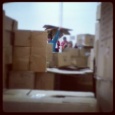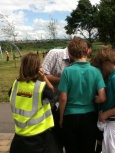Resources: Cross-curricular
- [[Topics/E-safety|E-safety]]
- [[Topics/Blogs|Blogs]]
- [[Topics/E-skills|E-skills]]
- [[Topics/CPD|CPD]]
- [[Topics/Creativity|Creativity]]
- [[Topics/Literacy|Literacy]]
- [[Topics/Curriculum development|Curriculum development]]
- [[Topics/Digital Art|Digital Art]]
- [[Topics/Discussion|Discussion]]
- [[Topics/E-safety|E-safety]]
- [[Topics/ICT|ICT]]
- [[Topics/Video|Video]]
- [[Topics/QR codes|QR codes]]
- [[Topics/Games|Games]]
- [[Topics/Geography in Education|Geography in Education]]
- [[Topics/Global education|Global education]]
- [[Topics/Maps|Maps]]
- [[Topics/Problem Solving|Problem Solving]]
- [[Topics/Science|Science]]
Relevant resources
| Blogs | Digital Reporters at Camp Cardboard | |

|
Children using iPads to blog about Cardboard Sculptures This activity is a cross curricula(subject) activity, involving a collaborative(tool) approach, giving children the opportunity to work together on a blog. Children were encouraged to engage in group talk(ta) and discussion(ta) in the classroom to reflect on the activity they were to report on. The activity furthers e-skills(topic) and e-safety(topic) through the use of whole class(ta) participation. The specific art activity provided a great stimulus for the blogging. Equally, however, this approach could be applied to any event in or out of school. The use of blogging and social media gave the opportunity for children to share their ideas with a wider audience, and also gave opportunities for real-time feedback to their work. The use of hand-held technology also enabled active learning(ta) as the portability of the iPads and iPods allowed them to be used outside the classroom.
| |
| CPD | Using Drama Activities in your Teaching | |

|
A lesson by any other name...Using Drama across the curriculum to enhance teaching This resource highlights some strategies to use drama(ta) activities in the teaching of other subjects. Drama(ta) can provide a useful cross curricula(i) way to prompt active learning(ta) and subsequent discussion(ta) and group talk(ta).
| |
| Creativity | Exploring the intersections of digital literacy and creativity | |

|
A DEFT case study with Mundella Primary School, Sheffield This cross curricula(i) case study focusses on Digital Literacy, in particular using E-skills(topic) to: extend/update teaching skills and support CPD and explore the creative potential of digital technologies. The case study examines the potential of using mobile technologies to enhance creative aspects of learning.
One of the lesson ideas from the case study is available as a separate resource at Creating Digital Paintings using iPads | |
| Digital Art | Creating Digital Painting using iPads | |

|
Children using iPads to create observational drawings of flowers This activity is a cross-curricular(subject) activity, that gives children to opportunity to work independently on an art activity that also encourages the development of E-skills(topic). This activity encouraged inclusion(ta) as the children's final work was displayed as a collaborative(tool) piece, where all children had the opportunity to make an equal contribution.
In this instance, the children created observational drawings of flowers. However, the subject of the art could change to fit with any topic across the curriculum. The use of hand-held technology could also active learning(ta) as the portability of the iPads and iPods would allow them to be used outside the classroom, thus enabling observational drawings to be made in a range of locations. | |
| Discussion | Discussion in Science Teaching | |

|
Equip yourself to run a discussion in class This resource is aimed at developing student teachers’ skills in working with discussion(ta). It can be presented to them as a hand-out to accompany an activity or read as reference material. See it online at BEEP website. Although it uses a science context, the real focus of the resource is managing and organising discussion-based activities. It provides guidance on:
| |
| Geography in Education | Geography in Education | |

|
Where is it? Exploring the place of geography in the curriculum This unit looks at the contribution that geography can make in the education of young people and the characteristics and purpose of geography as a subject.
| |
| Global education | A global dimension to science education in schools | |

|
Science and technology beyond the Western world This study unit is aimed at teachers who would like to give a more global feeling to their teaching. It shows how to source articles with an emphasis on science and technology beyond the Western world and how to incorporate them into teaching the curriculum.
| |
| ICT | Creating Instructional Videos | |

|
Children create instructional videos to upload to YouTube This activity is a cross-curricular(subject) activity with a literacy focus, involving a collaborative(tool) approach, giving children to opportunity to work together to produce a set of instructional resources. Children were encouraged to engage in group talk(ta) and discussion(ta) in the classroom to reflect on what they should include in their videos. The activity furthers e-skills(topic) through the use of whole class(ta) participation. It develops e-safety(topic) skills through discussion of the issues relating to posting digital content online. Children were allowed to choose their own subject for the video, although this could be set by a teacher with a specific outcome in mind, or could be tailored to cover a particular topic or subject. It could, for instance, be used to explain their mathematical thinking(ta).
| |
| Literacy | Developing Language in Primary Science | |

|
Language development and the use of appropriate vocabulary(ta) is highlighted as important across the curriculum. Incorporating this consideration into science planning(ta) is important for meeting the target of developing language. The importance of language and talk in science – including through group work(ta), and Whole class(ta) dialogue – is highlighted elsewhere (and in the resource) but includes the ability to explain concepts, understand synthesising ideas (including those from other people and texts), and the need to read and write for different purposes, (including conceptual understanding, data presentation, etc). These are key ideas in communicating the scientific method(ta) | |
| Maps | Restless Earth | |

|
How would you respond? Using maps to model disaster support and recover exercises. This is a free workshop offered by the British Cartographic Society (BCS). Students are assigned roles for group work(ta) tasks to represent various disaster recovery agencies. Learning and teaching focuses around small group work, co-inquiry(ta), exploring ideas alongside negotiation, enquiry-based learning as well as a final whole class(ta) dialogue(ta). The overall aim of the workshop is for each group to produce a map suitable to meet the needs of the various disaster recovery agencies. BCS organise and supervise the event on the day. They run the workshops throughout the year at a variety of locations. Schools can host their own event or attend an organised one elsewhere. The only proviso is that BCS have access to a large hall with Internet available. If you would like to host or attend a Restless Earth workshop please contact the British Cartographic Society via the following link: http://www.cartography.org.uk/default.asp?contentID=982 | |
| Problem Solving | Problem Solving in Primary Education | |

|
Encouraging primary pupils to think about problem-solving. Problem-solving and reasoning(ta) are important skills to learn, and engage with in teaching. This document provides some guidance and practical examples on how to use problem-solving skills in the primary curriculum.
| |
| QR codes | Editing Using QR Codes to Engage Children with Learning | |

|
Children using digital literacy to engage with reading and writing This lesson idea uses technology to promote active learning(ta) as resources were produced to be located and explored in a public park. The early stage of the activity, involving the creation of the resources by the children, required discussion(ta) involving the whole class(ta). Group talk(ta) was also employed as a strategy, with the children agreeing on a narrative(ta) outline relating to the event. The creation of the online materials encouraged development of e-skills(topic).
The later stages of activity, where the children were looking for clues, required them to ask questions(ta) and to take a collaborative(tool) approach to find a solution, based on the digital texts they found. | |
| Science | Listening to scientists - Using sensors and data loggers for agriculture | |

|
How do plant growers and scientists monitor the environment? What do they measure and why? This resource was made for general public interest but may find use as enrichment material for science, technology and geography.
| |
| Video | Digital Video in ITE | |

|
Student teachers producing digital media This activity is a cross-curricular(subject) activity, involving a collaborative(tool) approach, giving student teachers the opportunity to work together whilst making digital media in the form of films. The activity furthers e-skills(topic) and also helps to develop discussion relating to e-safety(topic). The topic of location provided the stimulus for the videos. Equally, however, this approach could be applied to any topic or subject in school. The use of video also encouraged active learning(ta), with the students developing their own skills through direct participation in the creation process.
| |

